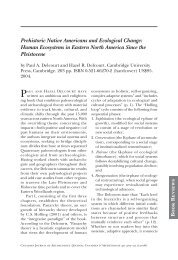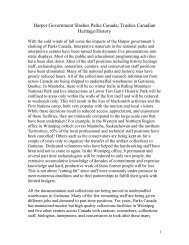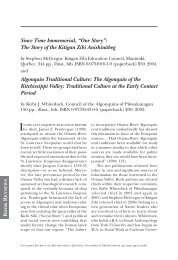(1): numéro de l'atelier / session number Abel, Tim - Canadian ...
(1): numéro de l'atelier / session number Abel, Tim - Canadian ...
(1): numéro de l'atelier / session number Abel, Tim - Canadian ...
- No tags were found...
You also want an ePaper? Increase the reach of your titles
YUMPU automatically turns print PDFs into web optimized ePapers that Google loves.
Bélanger, Christian (Université <strong>de</strong> Montréal) Le fort <strong>de</strong> Ville-Marie, 1642-1683. Versun premier plan archéologique <strong>de</strong>s vestiges (6) De nombreux vestiges <strong>de</strong> constructionassociés au fort <strong>de</strong> Ville-Marie ont été mis au jour au fil <strong>de</strong>s campagnes <strong>de</strong> fouilles. Lesstructures, parmi lesquelles figurent notamment un puits, <strong>de</strong>s segments <strong>de</strong> plusieurspalissa<strong>de</strong>s, <strong>de</strong>ux gran<strong>de</strong>s fosses d’emprise <strong>de</strong> bâtiment, divers ouvrages maçonnés enpierre ainsi que <strong>de</strong>s poteaux isolés, sont distribuées au travers <strong>de</strong> tous les secteursd’intervention, soit sur une superficie d’environ 150 mètres carrés. Dans le cadre <strong>de</strong> cetteprésentation, nous verrons que ces structures, bien qu’enchevêtrées en partie, sont pour laplupart inter-reliées et articulées dans l’espace et témoignent <strong>de</strong> l’existence d’un pland’ensemble d’aménagement dont nous tenterons <strong>de</strong> reconstituer les principalescaractéristiques. Il sera également fait mention <strong>de</strong> certaines difficultés d’interprétation quisubsistent, notamment en ce qui concerne la fonction <strong>de</strong> certains <strong>de</strong>s ouvrages mis au jour.Ville-Marie’s old fort (1642-1675). Toward a reconstructed map based on archaeologyThe remains of several structures associated with Ville-Marie’s old fort have come tolight over the years of excavation. They inclu<strong>de</strong> a well, segments of several palisa<strong>de</strong>s, twolarge building pits, various masonry remains and individual post-holes, distributedthroughout the excavation area of about 150 square metres. Analysis of these <strong>de</strong>nselypacked structures shows that they are interrelated and articulated as a single spatialensemble, revealing aspects of an original plan that we can partially reconstruct.Difficulties persist, however, in the interpretation of certain structural remains.Bélanger, François C. (Ville <strong>de</strong> Montréal) La prise en compte <strong>de</strong>s ressourcesarchéologiques dans un projet d’aménagement- Le cas du cimetière Saint-Antoine (27) LaVille <strong>de</strong> Montréal a développé une expertise qui lui permet <strong>de</strong> pratiquer une archéologiepréventive, s’insérant en amont <strong>de</strong>s projets d’aménagement et <strong>de</strong> construction et entravaillant <strong>de</strong> concert avec les architectes, architectes paysagistes, ingénieurs, urbanistes etarchéologues. Le cas du réaménagement du square Dorchester, <strong>de</strong> la place du Canada et<strong>de</strong>s rues adjacentes illustre bien cette expertise <strong>de</strong> prise en charge d’un patrimoinearchéologique funéraire. En effet, la présence du cimetière Saint-Antoine datant <strong>de</strong> 1799 à1854 incite à minimiser l’impact <strong>de</strong>s travaux sur les sépultures en place et à conserver insitu la quasi totalité du cimetière. Derrière tout cela, la Ville <strong>de</strong> Montréal affirme sonimplication dans la protection, la gestion et la mise en valeur <strong>de</strong> son patrimoinearchéologique. - The Ville <strong>de</strong> Montréal has <strong>de</strong>veloped an expertise which enables it topractice preventive archaeology, fitting upstream of installation and construction projectswhile working in liaison with the architects, landscape gar<strong>de</strong>ners, engineers, townplanners and archaeologists. The case of the refitting of Dorchester Square, of Place duCanada and the adjacent streets illustrates well this expertise of assumption ofresponsibility of a funerary archaeological heritage. In<strong>de</strong>ed, the presence of the Saint-Antoine cemetery going back to 1799 to 1854 encourages to minimize the impact of workon the burials in place and to preserve in situ to it quasi totality of the cemetery. Behindall that, the Ville <strong>de</strong> Montréal affirms its implication in protection, management and the<strong>de</strong>velopment of its archaeological inheritance.Belley, Frédéric (Institut d’Archéologie Saint-André) Why the Mayas Built Pyramids?A Comparative Analysis of the Water Supply System of Zapotitan (17) This paperexamines the meaning of the pyramids of Zapotitan, a territory that is not much studied.This area provi<strong>de</strong>s valuable information about the way the aboriginal population survived








